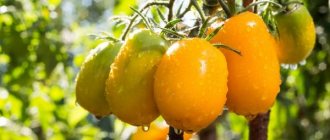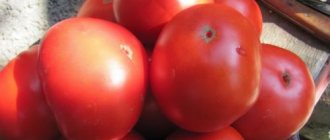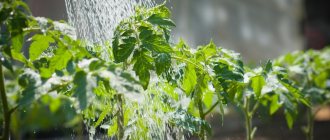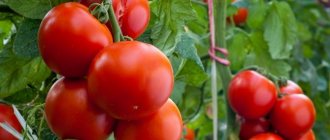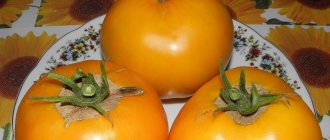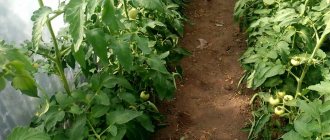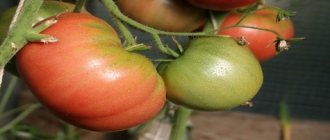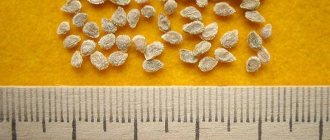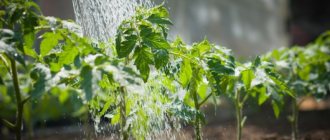Main characteristics of the Machitos tomato
The Makhitos tomato has characteristics; the characteristics and descriptions of the variety make it possible to determine comfortable conditions for growth and fruiting. The fruits of the plant are large, slightly flattened. The surface of the tomato is glossy, the stalk has a small depression. The tomato is adapted to grow in mid-latitude conditions.
Loves warmth, intended for greenhouses, but can adapt to open ground with loss of yield. Refers to self-pollinating.
The variety is mid-early, the fruits ripen at the same time. It takes 95-96 days from planting to harvesting tomatoes. It turns out that the harvest time approximately corresponds to the beginning of August, after this period the fruits are sent for ripening. In one season, the plant can produce 2 harvests.
Appearance of Machitos tomatoes
For reference! The name of this hybrid is often spelled incorrectly - some gardeners are looking for Mojito tomatoes, others are looking for the Mojito tomato variety.
Description of the variety
The hybrid "Machitos F1" is the product of the efforts of Dutch breeders. The tomato was bred in the village of De Lier in the south of the Netherlands. Over the quarter century of its existence, the company has not only conquered the local market, but is also actively promoting its products to other countries, including Russia, Ukraine, and Belarus.
Among the main characteristics of the hybrid, the following should be noted:
| Bush type | Indeterminate, tall, can reach 200 cm. |
| Description of the bush | A powerful, symmetrically formed open plant with good foliage. The stem and root system are well developed. The leaves are large, dark green, the distance between two adjacent nodes (branches) is small. |
| Ripening time | Early ripening (from 90 to 100 days from the moment of emergence). |
| Fruit | Quite large, on average from 220 to 260 g, round in shape, slightly flattened at the stalk, glossy. The pulp and skin have the same rich bright red color, without a green area on the stalk. Dense, meaty, very tasty (with subtle sweetish notes). |
| Productivity of the variety | High: more than 3 kg per bush, provided it is grown under film. |
Advantages and disadvantages
Like any fruit and vegetable crop, the Mahitos tomato has advantages and disadvantages. The first include:
- high level of germination;
- dense peel of the fruit;
- sweetish taste of tomato;
- the fruit does not crack during heat treatment;
- variety yield;
- seedlings begin to grow quickly after planting;
- plants are resistant to parasites;
- the fruits grow at the same time;
- ovary occurs even if the plants are not watered enough;
- the sprout forms a developed root system;
- fruits can be stored for a relatively long time;
- not afraid of drought.
A productive plant also has its drawbacks. Due to the possibility of high growth, the greenhouse must be suitable in height. Cuttings need to be tied up regularly to provide support. Disadvantages also include:
- with a lack of potassium and magnesium, the pulp becomes uneven in color;
- cannot be propagated by seeds;
- high cost of planting material;
- does not adapt well to growing outdoors.
The Makhitos variety is intended for growth in a greenhouse
Planting in a greenhouse
When the shoots reach a height of 15 cm, you can begin planting the finished seedlings in a permanent place. Before this, you need to prepare the soil, namely, thoroughly loosen it so that the soil turns out to be light. Fertilizer is placed in the prepared holes.
Due to the abundant foliage of an adult plant, the bushes are placed at a distance of at least 50-60 cm from each other.
Factors influencing the development of culture
Despite the high performance characteristics of the variety, growing the plant requires taking into account a number of factors. If the optimal requirements are not met, the yield will be affected. These factors are:
- timely watering;
- optimal temperature parameters;
- getting rid of leaves;
- maintaining air humidity;
- a certain feeding regime.
In order for tomatoes to grow well, it is important not to overwater the plant after planting. Each growth period has its own characteristics that you need to know about. If you do not take them into account, the plant will grow, the ovary will form late, and the number of extra stepsons will increase.
Comfortable temperature for the plant is the range of +21..+27 °C. Higher and lower values will most likely not harm the plant unless the changes are drastic.
Tomato Mahitos F1, during fruit growth, you need to get rid of excess leaves so that all the beneficial substances go to the tomatoes and not to other vegetative parts. Also, thinning the foliage rids the plant of unnecessary shadow. But pruning is carried out moderately so that the bush retains its ability to cool through the above-ground part.
What to do with leaves
Excess foliage draws juices from the plant. If there is a lot of it, then the fruits are smaller, take longer to ripen and are not so sweet. However, it is also impossible to remove a large number of leaves. The density of the bush is an important characteristic of Machitos. If you remove a lot of foliage, the tomato will get a lot of stress, because through it the plant cools, receives moisture and oxygen. Plucking the bush must be done partially. Leaves are cut off only from below and where they interfere with the ripening of the fruit, shading the sun.
The video talks about growing Machitos:
Features of cultivation and care recommendations
At the initial stage, the development of this variety is no different from any others. Sowing seeds begins approximately 55 days before planting tomatoes in the ground. They are pre-soaked in a solution of a growth stimulator.
Tomato seedlings Mahitos
You can buy soil for tomatoes in the store or prepare it yourself. The latter option is preferable, since it will allow the plant to endure less stress and take root faster.
The composition of the soil should be neutral acidity (pH 6.5-7), which is achieved by mixing:
- soil from the area where it will grow;
- river sand;
- peat;
- organic fertilizers.
Important! Fresh manure is not suitable as a fertilizer at this stage.
The components are mixed in equal proportions and ash is added. The finished substrate must be disinfected. This can be done in several ways:
- spilling copiously with a solution of potassium permanganate;
- keeping in the oven for half an hour at a temperature of 70-90 ° C;
- placing it in the freezer for a day or in conditions below -15 ° C.
The seeds are placed in the soil to a depth of 1 cm in increments of 2.5-3 cm. Then the soil is watered, adding a disinfectant composition (a special or weak solution of potassium permanganate) to the liquid. After sowing, the container is covered with film or glass and placed in a warm place under a lamp.
Growing and planting seedlings
After the shoots emerge, the glass is removed from the box, leaving the young shoots exposed. After the formation of 2 leaves, the sprouts are planted in individual pots.
When the seedlings reach 10-15 cm, and the number of leaves reaches 5-6 pieces, the sprouts become stronger and the external conditions become suitable, they are transferred to the greenhouse.
Important! If you miss the deadline for planting in the ground, the shoot will not take root well. If flowers have already formed on it, they must be removed, since the ovary will not form when transferred to the soil.
In the greenhouse, they begin to care for the plant, taking into account the characteristics of the variety. The stem needs space because it grows tall and bears fruit abundantly.
The sprouts are planted in rows, the distance between which should be 1 m, the seedlings are planted every 40 cm. As the bush grows, you need to leave 2 stems in order to get an optimal harvest and a strong stem.
Watering and fertilizing
Water the seeds generously when sowing, then after planting in the ground, reduce the volume of liquid. A signal to increase the volume of irrigation is the formation of 2-3 brushes on the sprout.
The optimal volume of fluid intake is considered to be 4-6 liters per day. If you use a drip irrigation system, you need to install it separately for tomatoes or be able to stop the flow of water to the greenhouse.
Feeding tomatoes
The Machitos tomato variety needs to be fed when the number of shoots on the bush reaches 3-4 pieces. It will no longer be necessary to repeat during the active period.
Stepsoning
Each shoot of the plant needs nutrition, so their excess quantity affects the subsequent number of fruits.
Stepchildren are shoots that begin to grow from the axil of the leaf. Mahitos tomatoes, as a tall variety, produce a large number of additional shoots. Therefore, the variety needs to be removed (pinching), due to which an increase in yield is observed.
Attention! The procedure on soil poor in microelements can lead to slower growth of the shoot and its death.
Stepping is carried out every 10 days. The sprout must be torn off with your fingers at a level of 1 cm from the mouth. The stepson should not grow more than 10 cm.
Photo
For a more thorough study of the Mahitos variety, you can see the photographs below.
You can also watch a video where an experienced gardener will tell you how the Machitos tomato variety grew in a greenhouse.
Given its simplicity, minimal susceptibility to disease and survival in all conditions, the Machitos variety is certainly worthy of the attention of gardeners. Follow all the recommendations and get a rich harvest.
Measures to protect against diseases and pests
Tomato Machitos is immune to nematodes, verticillium, cladosporiosis and tobacco mosaic. Despite the high genetically determined resistance to pests, it is recommended to treat tomatoes against:
- gray rot;
- anthracnose;
- streak;
- late blight.
To prevent weakened immunity, it is important to maintain high light levels and avoid excess moisture. If signs of disease appear, you should remove the affected fruits, increase the temperature in the greenhouse, and reduce the humidity level.
After this, it is highly advisable to establish the type of violation and treat the above-ground parts with a special solution. If the roots begin to rot, then you need to treat the underground part of the plant with copper sulfate and change the layer of substrate in which the tomato grows.
On tomatoes you can notice the proliferation of whiteflies, bedbugs and mites, mole crickets and Colorado potato beetles, and wireworms. They attack leaves and the area around them. The first insect is a small butterfly that breeds on the inside of the leaf. The larva feeds on the sap of the plant and forms a viscous secretion, preventing it from breathing.
Bedbugs come in different sizes; the shoots growing next to the weeds are the first to be affected. A lesion can be suspected by the appearance of brown or white spots on the skin. The leaves of the plant curl and die.
The Colorado potato beetle lays larvae on the back of the leaves, and the offspring appear after 10 days. If they grow, they eat the bush in 3-4 days.
The mole cricket is a large beetle that digs tunnels underground. It damages the roots of the tomato, which causes its death.
The only way to get rid of parasites is to timely treat the bush. It is best to prevent pests from appearing and water the bush for preventive purposes. To do this, you need to deeply plow the soil in the fall and add a solution of chemicals before planting.
For reference! As an additional preventive measure, tomatoes are planted away from other nightshade crops (potatoes, eggplants, peppers).
Farmer reviews
Makhitos f1 tomatoes have been highly appreciated by large farmers and amateur gardeners due to their excellent taste, productivity and relative ease of care.
Victoria, Pechory, Pskov region : “The Makhitos hybrid made a real splash in our region several years ago. Raspberry tomatoes flooded the markets, and red ones lost popularity. The situation has changed dramatically with the appearance of the seeds of this hybrid on our market. Tomatoes have an amazing taste, they are suitable for making salads and winter twists. Caring for the crop is simple; The main thing is to follow the manufacturer’s recommendations - do not overwater or overfeed.”
Kirill, Bataysk, Rostov region: “I am engaged in growing tomatoes for sale. Machitos are on the list of favorites. I have been planting it in a greenhouse for three years in a row. Last year I planted several bushes in the garden as an experiment. Culture loves the sun, so in our conditions this is permissible. The technology is the same as in a greenhouse. The yield was lower, but the tomatoes were much tastier, sweeter and the color was uniform. I know that some farmers feed tomatoes with growth hormones to form a “spout,” but I think this is unnecessary. The fruits have an excellent presentation even without this.”
Harvesting
There are 3 stages of tomato ripening. The first occurs when fruit growth stops and the skin becomes lighter. Technological maturity is determined when the tomatoes turn pink when cut. After a couple of days, the tomatoes reach consumer ripeness.
Harvesting tomatoes
You can start harvesting a month after transplanting into open ground. The first fruits are small, a month after the start of the season they grow to average size. During this period their number is maximum.
Tomatoes of this variety do not ripen at the same time, so the fruits are removed from the bush in stages over a long period of time.
Mahitos tomatoes are a productive mid-early variety that ripens in late June-July. The plant grows up to 2 m, so it requires staking. The variety is highly resistant to pests and diseases. Due to their different weights, tomatoes reach the consumer stage of ripeness at different times.
